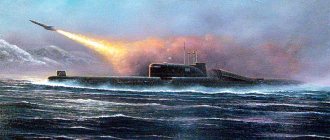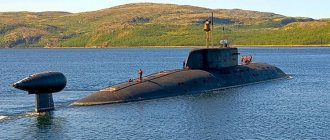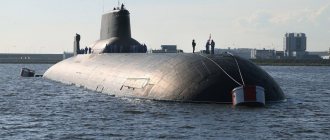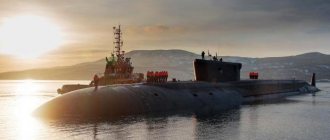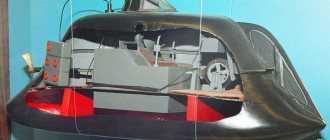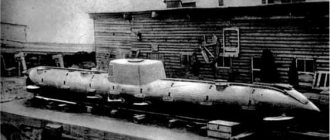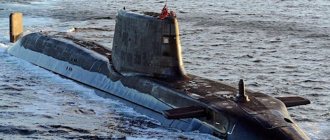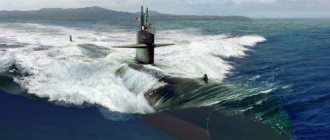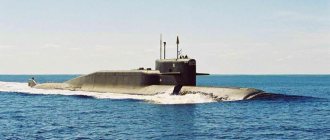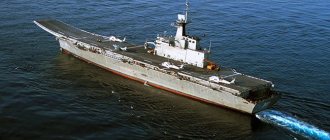The history of the development of the submarine fleet covers the entire 20th century, however, until 1944, all ships of this class were considered surface ships and could not remain under water for a long time. Germany played an important role in the development of the submarine fleet. During the First World War, it was German submarines that brought Great Britain to the brink of defeat.
The history of the Russian submarine fleet includes a period when submarines were imperfect and the current stage of development of new generation weapons. Let's talk about the largest submarine in the world, the size of which can be compared to the size of an apartment building.
"Triumfan"
French strategic nuclear submarine. Its name means "triumphant". The length of the boat is 138 meters, the displacement is 14 thousand tons. The ship is armed with three-stage M45 ballistic missiles with multiple warheads, equipped with individual guidance systems. They are capable of hitting targets at a distance of up to 5,300 kilometers. At the design stage, the designers were tasked with making the submarine as invisible as possible to the enemy and equipping it with an effective early detection system for enemy anti-submarine defense systems. Careful study and numerous experiments have shown that the main reason for revealing the location of an underwater vessel is its acoustic signature.
When designing the Triumphan, all known noise reduction methods were used. Despite the impressive size of the submarine, it is a rather difficult object to detect acoustically. The specific shape of the submarine helps reduce hydrodynamic noise. The sound level produced during operation of the ship's main power plant has been significantly reduced thanks to a number of non-standard technological solutions. "Triumphan" has on board an ultra-modern sonar system designed for early detection of enemy anti-submarine weapons.
Construction specifics
The object is distinguished by its particularly light overall body. Interestingly, there are five habitable durable hulls located inside. Of these, the two main ones are of maximum size and are positioned according to the principle of a catamaran. The buildings are connected to each other using three transitions. In addition, they are divided into eight compartments. Among them:
- reactor and turbine, the total length of which is about 30 m;
- three bow compartments in 54 m;
- troika, which is adjacent to the main command post - 31 m.
Among the three remaining hulls there is a well-separated bow one - the torpedo compartment is based here. There is also a room where radio equipment is located and the last one is the aft transition building.
Some compartments are made of titanium alloy, others are based on steel with an anti-hydroacoustic coating. In a large third-generation power plant there is a block installation of a pair of echelons, which are located on two sides of the board.
"Jing"
Strategic nuclear-powered missile submarine built for the Chinese Navy. Due to the increased level of secrecy, much of the information about this ship comes not from the media, but from the intelligence services of the United States and other NATO countries. The submarine's dimensions were determined based on a photograph taken in 2006 by a commercial satellite designed to take digital images of the earth's surface. The length of the vessel is 140 meters, displacement - 11 thousand tons.
Experts note that the dimensions of the Jin nuclear submarine are larger than the dimensions of previous, technically and morally obsolete Chinese Xia-class submarines. The new generation vessel is adapted to launch Julan-2 intercontinental ballistic missiles equipped with multiple nuclear warheads. Their maximum flight range is 12 thousand kilometers. The Julan-2 missiles are an exclusive development. When designing them, the dimensions of the Jin class submarines, intended to become carriers of these formidable weapons, were taken into account. According to experts, the presence of such ballistic missiles and submarines in China significantly changes the balance of power in the world. Approximately three-quarters of the territory of the United States is in the zone of destruction of the Jin boats located in the Kuril Islands area. However, according to information available to the US military, test launches of Julan missiles often end in failure.
"The Last Day of the Confederacy" 140 Years Later
The Hunley did not return to base. There have been debates about her fate for almost a century and a half. Many were inclined to believe that the submarine died during a mine explosion. At the same time, there was information that the Confederate post had received a prearranged signal from the crew that the attack had been successful.
In the 1970s, active searches for the Hanley began, and in 1995 the location of her death was reliably established. In 2000, the hull of the boat was raised to the surface. It is assumed that the boat, which was damaged by the explosion, made another dive, could not surface again, and the crew died from lack of oxygen.
In 2004, a solemn funeral for the last crew of the Hunley took place in Charleston. The American media called this day “the last day of the Confederacy.”
The restored boat itself is now on display at the Warren Lasch Restoration Center in North Charleston, South Carolina.
"Vanguard"
British strategic nuclear submarine, the size of which allows it to compete with the largest submarines in the world. The length of the vessel is 150 meters, displacement - 15 thousand tons. Boats of this type have been in service with the Royal Navy since 1994. Today, Vanguard-class submarines are the only carriers of British nuclear weapons. They are equipped with Trident-2 ballistic missiles. This weapon deserves special mention. It is produced by the famous American for the US Navy. The British government took on 5% of the cost of developing the missiles, which, according to the designers' plans, were supposed to surpass all their predecessors. The Trident-2's affected area is 11 thousand kilometers, and the accuracy of the hit reaches several feet. Missile guidance does not depend on the American global positioning system. Trident 2 delivers atomic warheads to a target at a speed of 21 thousand kilometers per hour. The four Vanguard boats carry a total of 58 of these missiles, representing the UK's "nuclear shield".
Tactical and technical data
The equipment of the facility is impressive. Once the Head of the Northern Fleet Directorate said that it was enough to show this submarine to the whole world as a monument so that all countries would once and for all lose the idea of starting a war.
We are talking here not even about the great potential and modern weapons, which are hidden from prying eyes, but about the impressive, threatening appearance of the ship. Thus, the length of the vessel reaches almost 173 m, and the width and height are 23 m.
The maximum diving depth is 500 m; the boat can operate autonomously for 180 days. As for the speed on the surface, the figure reaches 13 knots; when diving, the speed increases to 26.
"Murena-M"
Soviet submarine built during the Cold War. The main goals of creating the boat were to increase the range of missiles and overcome American sonar detection systems. Expanding the affected area required changing the dimensions of the underwater vessel compared to previous versions. The launch silos of the Murena-M boat are designed for D-9 missiles, the launch mass of which is twice the usual. The length of the ship is 155 meters, displacement is 15 thousand tons. According to experts, Soviet designers managed to complete the initially set task. The range of the missile system has increased approximately 2.5 times. To achieve this goal, the Murena-M submarine had to be made one of the largest submarines in the world. The size of the missile carrier did not change the level of its stealth for the worse. The design of the boat included vibration damping mechanisms, since at that time the US sonar tracking system became a serious problem for Soviet strategic submarines.
Armament
The cruiser's main armament is the D-19 missile system with the largest ballistic missiles in the world (launch weight - 90 tons), which are in service with submarines. The set consists of 20 pieces, although the project included 24. Since the P-39s were long, they could only be installed on Akula-class submarines. Flight range - 8300 km.
Over time, the R-39 SLBMs became obsolete and were replaced by ballistic missiles called “Bulava” with a flight range of 9,300 meters. Also, 6 torpedo tubes are installed as the main armament. Torpedo caliber - 553 mm.
Launch of a Bulava missile from the Barents Sea
Eight Igla MANPADS systems provide protection against air attack. Additionally installed equipment for:
- providing radio and satellite communications;
- establishing the fact of the presence of ice cover on the surface;
- navigation;
- detection of underwater objects.
Gradually, the submarine equipment was replaced with the latest without changing its purpose or characteristics.
"Ohio"
The US Navy operates 18 submarines of this class, capable of carrying half of the country's thermonuclear arsenal. The dimensions of the largest submarine in US history are amazing. In terms of dimensions, Ohio has almost no competitors in the world. Only the size of the Russian submarines “Borey” and “Akula” beats the record of the American giant. The length of the Ohio is 170 meters, displacement is 18 thousand tons. Boats of this type are designed for long patrols and intimidation of potential opponents. Ohio has no equal in the number of launch silos: the ship can accommodate 24 Trident-2 ballistic missiles. According to some reports, the submarine has a very low noise level, but exact information about this remains classified. Four Ohio class boats were converted in 2003 to carry Tomahawk cruise missiles.
"Borey"
The development of this nuclear submarine began in the Soviet Union. It was finally designed and built in the Russian Federation. Its name comes from the name of the ancient Greek god of the north wind. In accordance with the plans of the creators, the Borey boat in the foreseeable future should replace the Akula and Dolphin class submarines. The length of the cruiser is 170 meters, displacement - 24 thousand tons. Borei was the first strategic submarine built in the post-Soviet era. First of all, the new Russian boat serves as a platform for launching Bulava ballistic missiles equipped with multiple nuclear warheads. Their flight range exceeds 8 thousand kilometers. Due to problems with financing and disruption of economic ties with enterprises located on the territory of the former Soviet republics, the completion date of the ship's construction was repeatedly postponed. The Borey boat was launched in 2008.
Submarines of the Russian Navy
The most important part of the navy are its submarines. Modern submarines can perform a wide range of missions to detect and destroy enemy ships, submarines or ground targets. In addition, the naval component of the strategic nuclear forces is built entirely on submarines. Currently, as part of the renewal of the Navy, new submarines of various types are being built. In the foreseeable future, the fleet should receive several dozen submarines, both strategic or multi-purpose, and diesel-electric or special. However, for now, the basis of the submarine fleet in quantitative terms are submarines built earlier, including before the collapse of the Soviet Union. The four fleets of the Russian Navy (with the exception of the Caspian Flotilla) currently serve a total of 76 submarines of various types. Strategic missile submarines (SSBNs), nuclear attack submarines, diesel submarines, as well as a number of special purpose nuclear and diesel submarines are in service and in reserve.
Strategic missile cruisers
The basis of the naval component of the nuclear forces are the Project 667BDRM Dolphin nuclear submarines. Currently, the Russian Navy has six such submarines: K-51 "Verkhoturye", K-84 "Ekaterinburg", K-114 "Tula", K-117 "Bryansk", K-118 "Karelia" and K-407 "Novomoskovsk". The submarine "Ekaterinburg" is currently undergoing repairs. Completion of work and delivery of the boat is scheduled for the end of this year. Another submarine of the Dolphin project, K-64, was withdrawn from the fleet in 1999 and soon went for refurbishment. All six Project 677BDRM submarines serve in the Northern Fleet.
The second largest type of SSBN in the Russian Navy is Project 667BDR “Squid”. Submarines of this type were built from the mid-seventies to the early eighties. Most of the Kalmar submarine cruisers have now been decommissioned and disposed of. Currently, the fleet has only three submarines of this type: K-433 “St. George the Victorious”, K-223 “Podolsk” and K-44 “Ryazan”. The latter is the newest of the existing Project 667BDR submarines and was delivered to the fleet in 1982. All three Kalmars serve in the Pacific Ocean.
Until the mid-nineties, nuclear deterrence tasks were carried out by the K-129 Orenburg submarine, built according to project 667BDR. In 1996, it was decided to convert it into a carrier for deep-sea vehicles. Currently, Orenburg belongs to project 09786 and is designated BS-136.
The Northern Fleet has three nuclear submarines of projects 941 and 941UM “Akula” in service and in reserve. The heavy missile cruiser TK-208 “Dmitry Donskoy” continues to serve. This was facilitated by repairs and modernization in accordance with Project 941UM, during which the submarine received equipment for the Bulava missile system. Two other Akulas, the TK-17 Arkhangelsk and the TK-20 Severstal, were put into reserve in the middle of the last decade due to the lack of R-39 missiles. Their future fate has not yet been determined.
In January 2013, a flag-raising ceremony took place on the lead SSBN of the new Project 955 Borei. The submarine K-535 Yuri Dolgoruky, under construction since 1996, passed all tests and was handed over to the fleet. At the end of December of the same year, the submarine cruiser K-550 Alexander Nevsky was accepted into the Navy. The lead submarine of the Borei project became part of the Northern Fleet, the first production submarine became part of the Pacific Fleet.
Multipurpose nuclear submarines
The tasks of destroying various surface, underwater and coastal targets are assigned to multi-purpose nuclear submarines armed with cruise missiles and torpedoes. The most popular nuclear submarines of this class are the Project 971 Shchuka-B submarines. The Russian Navy has 11 submarines of this type, distributed between the Northern and Pacific fleets. Five Shchuka-B submarines serve in the Pacific Fleet, six are in the Northern Fleet. At the moment, five Project 971 submarines are undergoing repairs or are being prepared for them. To date, the Navy has lost three submarines of this type. The K-284 "Akula" boat has been in storage since 2002, the K-480 "Ak Bars" was handed over for disposal at the end of the last decade, and the dismantling of the K-263 "Barnaul" started last year.
The fate of the K-152 “Nerpa” boat is worth special consideration. It was laid down in 1991 for the domestic fleet, but financial difficulties led to the failure of all work deadlines. In 2004, a contract was signed, according to which the submarine was planned to be completed and transferred to the Indian Navy. After a number of difficulties, all work was completed, and in January 2012 the submarine was accepted by the customer.
The second largest multipurpose nuclear submarines in the Russian Navy are Project 949A Antey submarines. There are 5 and 3 submarines of this type in service in the Pacific and Northern fleets, respectively. Initially, it was planned that the Navy would receive 18 of these submarines, but the financial capabilities of the fleet allowed the construction of only 11. To date, three boats of the Antey project have been out of service. In August 2000, the K-141 Kursk submarine tragically died, and since the end of the 2000s, work has been underway to dismantle the K-148 Krasnodar and K-173 Krasnoyarsk submarines. Of the remaining submarines, four are currently undergoing repairs.
From the late seventies to the early nineties, four submarines of projects 945 Barracuda and 945A Condor were built. The ships B-239 “Karp” and B-276 “Kostroma” were built according to project 945, and the ships B-534 “Nizhny Novgorod” and B-336 “Pskov” were built according to project 945A. All these submarines are part of the Northern Fleet. Last year, work began on the repair and modernization of the Karp submarine. After it, Kostroma will undergo repairs. "Pskov" and "Nizhny Novgorod" continue to serve.
Until now, four Project 671R multi-purpose nuclear submarines remain in the Northern Fleet. Two submarines, B-414 Daniil Moskovsky and B-338 Petrozavodsk, continue to serve, while the other two, B-138 Obninsk and B-448 Tambov, are under repair. In accordance with current plans, all the Shchukas in the fleet will end their service in the foreseeable future. It was previously reported that all of them will be written off by the end of 2015. They will be replaced by new types of multi-purpose submarines.
On June 17, 2014, a flag-raising ceremony took place on the K-560 Severodvinsk submarine, the lead and so far only ship of Project 885 Yasen. The first Yasen was laid down at the end of 1993 and launched only in 2010. By 2020, it is planned to build 8 Yasen-class submarines equipped with missile weapons. Due to the long construction time for the lead submarine, all other submarines in the series will be built according to the updated 885M project. Currently, there are three new type submarines on the stocks of the Sevmash enterprise: Kazan, Novosibirsk and Krasnoyarsk.
Non-nuclear submarines
Since the early eighties, several domestic shipyards have been engaged in serial production of Project 877 Halibut diesel-electric submarines. Over the past decades, several versions of this project have been created, thanks to which Halibuts of various modifications have become the most popular submarines in the Russian Navy.
The Baltic Fleet has two submarines of the Halibut project: B-227 Vyborg and B-806 Dmitrov (Project 877EKM). The Black Sea Fleet has only one Project 877B boat - the B-871 Alrosa. The Northern Fleet has the second largest group of Halibuts - five Project 877 diesel-electric submarines and one Project 877LPMB. Finally, eight Project 877 Halibut diesel-electric submarines serve at the bases of the Pacific Fleet.
A further development of Project 877 is Project 636 “Varshavyanka” and its versions. On August 22, 2014, the lead submarine of Project 636.3, the B-261 Novorossiysk, was accepted into service with the Black Sea Fleet. By the end of the decade, the Black Sea Fleet will receive five more submarines of this type. Two of them, B-237 Rostov-on-Don and B-262 Stary Oskol, have already been launched.
Until recently, great hopes were placed on the Project 677 Lada diesel-electric submarines, which are a further development of the Halibuts. Previously, there were plans to build a series of several Project 677 boats, but tests of the lead ship forced serious adjustments to be made to them. As a result, the first submarine of the project, B-585 St. Petersburg, is in trial operation by the Northern Fleet. Two production ships of Project 677 are under construction. Due to problems with the lead submarine, the construction of serial submarines was suspended for some time.
Special equipment
In addition to combat submarines, the Russian Navy has a number of special submarines and underwater vehicles designed to perform specific tasks of various kinds. For example, the Baltic, Northern and Pacific fleets operate four Project 1855 Priz deep-sea rescue vehicles.
According to open data, the Northern Fleet has 10 special-purpose nuclear and diesel-electric submarines designed to perform various tasks. This equipment is intended to carry out research work, conduct rescue operations and ensure combat duty of submarine missile cruisers. The most famous representative of this class of equipment is the special AS-12 Losharik submarine, capable of diving to depths of several kilometers. It was reported that in September 2012, Losharik participated in research work in the Arctic, during which its crew collected soil samples at a depth of more than 2 kilometers.
In the future, the Russian Navy should receive a number of new special-purpose submarines. Thus, since 2012, the Belgorod submarine of Project 949A has been completed according to a special project, thanks to which it will be able to become a carrier of deep-sea research vehicles. Last spring, representatives of the Navy claimed that the military department plans to build a special hydroacoustic patrol submarine, the task of which will be to detect underwater targets at a distance of up to several hundred kilometers.
Prospects
At the moment, in total, the Russian Navy has more than seven dozen submarines and devices for various purposes. The vast majority of this equipment was built before the collapse of the Soviet Union, which has a corresponding impact on both the condition and capabilities of the submarine fleet. However, in recent years, a number of measures have been taken to update it. In accordance with current plans, the Navy should receive a relatively large number of new submarines by 2022.
By the end of this decade, the fleet will receive eight Project 955 Borei strategic missile carriers, the same number of Project 885 Yasen multi-purpose nuclear submarines and six Project 636.3 Varshavyanka diesel-electric submarines. Nuclear-powered Borei and Yasen missiles will be distributed between the Northern and Pacific fleets. “Varshavyanka”, in turn, will serve at Black Sea bases. Previously it was reported about plans regarding the future project 677 Lada. In the near future, it is planned to develop an updated version of this project, which will use a new power plant. The successful completion of this project will expand plans for the construction of non-nuclear submarines.
In parallel with the construction of new submarines, the old ones will be decommissioned. For example, by 2015-16 it is planned to stop operating the remaining Project 671R nuclear submarines. Almost all submarines of this type have already been withdrawn from the fleet and disposed of, and only four remain in service. Over time, similar processes will occur with other types of submarines, which will be replaced by the new Yasen, Borei, Varshavyanka and, possibly, Lada. However, a complete renewal of the submarine fleet will take a long time and will be one of the most expensive projects in the entire history of the Russian Navy.
Based on materials from the sites: https://ria.ru/ https://rg.ru/ https://flot.sevastopol.info/ https://flotprom.ru/ https://flot.com/
"Shark"
According to NATO classification, this vessel is designated “Typhoon”. The dimensions of the Akula submarine exceed everything that has been created throughout the history of submarines. Its construction was the Soviet Union's response to the American Ohio project. The huge size of the heavy submarine cruiser "Akula" was due to the need to deploy on it R-39 missiles, the mass and length of which significantly exceeded those of the American Trident. Soviet designers had to come to terms with large dimensions in order to increase the flight range and weight of the warhead. The Akula boat, adapted to launch these missiles, has a record length of 173 meters. Its displacement is 48 thousand tons. Today, the Akula remains the largest submarine in the world.
